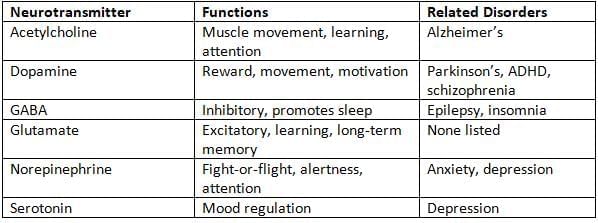The Neuron and Neural Firing Chapter Notes | AP Psychology - Grade 11 PDF Download
| Table of contents |

|
| Introduction |

|
| Neuron Structures and Functions |

|
| Neural Transmission Process |

|
| Psychoactive Drugs and Behavior |

|
Introduction
Picture your brain as a bustling city where neurons and glial cells are the workers, constantly chatting to keep everything running. These tiny cells are the stars of the nervous system, sending signals that control your thoughts, movements, and feelings. In this chapter, we’ll dive into how neurons communicate through electrical and chemical signals, how reflexes work without your brain’s input, and how chemicals like neurotransmitters, hormones, and drugs shape your behavior. From the spark of a neural signal to the effects of a cup of coffee, get ready to explore the amazing world of neural firing!
The Neuron and Neural Firing
- Neurons and glial cells form the nervous system’s foundation.
- Neurons send electrical and chemical signals to control behavior and thoughts.
- Glial cells support neurons to keep the system working.
- Neural transmission is how neurons communicate using precise steps.
- Neurotransmitters and hormones act as chemical messengers affecting behavior.
- Psychoactive drugs alter neurotransmitter activity, changing behavior.
Quick Cram Review
- Neurons send signals to manage behavior and thinking.
- Glial cells provide support for neurons.
- Neural transmission uses electrical and chemical signals for communication.
- Psychoactive drugs affect neurotransmitters:
- Stimulants speed up neural activity.
- Depressants slow down neural activity.
- Hallucinogens alter perception.
- Opioids relieve pain.
Neuron Structures and Functions
Neural Cells in Behavior
- Neurons and glial cells are the nervous system’s main units.
- Neurons process and send information through signals.
- Neurons form networks for complex information processing.
- Neurons connect to create neural circuits.
- Glial cells support neurons by:
- Providing structural support for neural networks.
- Insulating neurons to improve signal speed.
- Helping neurons communicate.
- Removing waste to keep neurons healthy.
- Neurons and glial cells enable all behaviors and mental processes.
Spinal Cord Reflex Arc
- Reflex arc is a simple neural circuit for quick, automatic responses.
- Occurs in the spinal cord without brain involvement.
- Example: Pulling hand away from a hot stove before feeling pain.
- Key components:
- Sensory neurons detect the stimulus (like heat).
- Interneurons relay signals within the spinal cord.
- Motor neurons activate muscles for response (like pulling hand).
- Process happens before conscious awareness.
Neural Transmission Process
Neural Transmission Mechanisms
- Neural transmission follows a specific sequence for communication.
- Steps include:
- Resting potential: Neuron has negative charge inside.
- Stimulus reaches threshold to trigger signal.
- Action potential fires (all-or-nothing response).
- Depolarization occurs, changing the charge inside neuron.
- Refractory period prevents immediate refiring.
- Reuptake recycles neurotransmitters to end the signal.
- Disruptions cause disorders:
- Multiple sclerosis: Damaged myelin slows signal transmission.
- Myasthenia gravis: Antibodies weaken muscle signals.
- Sodium-potassium pump is not covered on AP Psych exam.
Neurotransmitters
- Neurotransmitters are chemical messengers for neural communication.
- Excitatory neurotransmitters increase chance of neural firing:
- Glutamate: Most common, supports brain activity.
- Norepinephrine: Boosts arousal and alertness.
- Inhibitory neurotransmitters decrease chance of neural firing:
- GABA: Main inhibitory, balances excitation.
- Serotonin: Regulates mood, sleep, and appetite.
- Some neurotransmitters have both effects:
- Dopamine: Affects motivation, reward, and motor control.
- Acetylcholine: Supports muscle movement, learning, and memory.
- Endorphins: Provide natural pain relief and euphoria.
- Substance P: Signals pain from body to brain.
Note: AP Psych exam covers only these neurotransmitters.
Neurotransmitters

Hormones
- Hormones are chemical messengers produced by glands.
- Travel through bloodstream to affect behavior and mental processes.
- Key hormones:
- Adrenaline (epinephrine): Triggers fight-or-flight response.
- Leptin: Regulates fullness and body weight.
- Ghrelin: Stimulates hunger and food-seeking.
- Melatonin: Controls sleep cycles based on light.
- Oxytocin: Promotes social bonding and trust.
Note: AP Psych exam covers only these hormones. Endocrine system glands are not covered on AP Psych exam.
Psychoactive Drugs and Behavior
Drug Effects on Neurotransmitters
- Psychoactive drugs alter neurotransmitter systems to change behavior.
- Three mechanisms:
- Agonists: Mimic or enhance neurotransmitter effects, increasing firing (e.g., opioids mimic endorphins).
- Antagonists: Block neurotransmitter effects, reducing firing (e.g., caffeine blocks adenosine).
- Reuptake inhibitors: Prevent neurotransmitter reabsorption, prolonging activity (e.g., Prozac for serotonin).
Psychological and Physiological Effects
- Stimulants increase neural activity:
- Mild: Caffeine, nicotine.
- Potent/addictive: Cocaine, amphetamines.
- Depressants reduce neural activity:
- Alcohol: Affects judgment, coordination, memory.
- Benzodiazepines (e.g., Xanax, Valium): Treat anxiety, sleep issues.
- Hallucinogens alter perception:
- Marijuana (THC): Affects sensory processing, judgment, memory.
- LSD, psilocybin: Cause hallucinations, dissociation.
- Opioids relieve pain and induce euphoria:
- Prescription: OxyContin, Vicodin for severe pain.
- Illegal: Heroin, high risk of addiction.
Drug Tolerance and Addiction
- Tolerance: Brain adapts to drugs, needing larger doses for same effect. Tolerance reflects brain’s attempt to balance drug effects.
- Addiction involves:
- Compulsive drug use despite harm.
- Activation of brain reward systems.
- Withdrawal symptoms when stopping:
- Physical: Nausea, tremors.
- Psychological: Anxiety, cravings.
- Severity depends on drug type and usage.
|
35 docs
|
FAQs on The Neuron and Neural Firing Chapter Notes - AP Psychology - Grade 11
| 1. What are the main parts of a neuron and their functions? |  |
| 2. How does a spinal cord reflex arc work? |  |
| 3. What is the process of neural transmission? |  |
| 4. What roles do neurotransmitters play in the nervous system? |  |
| 5. How do psychoactive drugs influence behavior? |  |



















